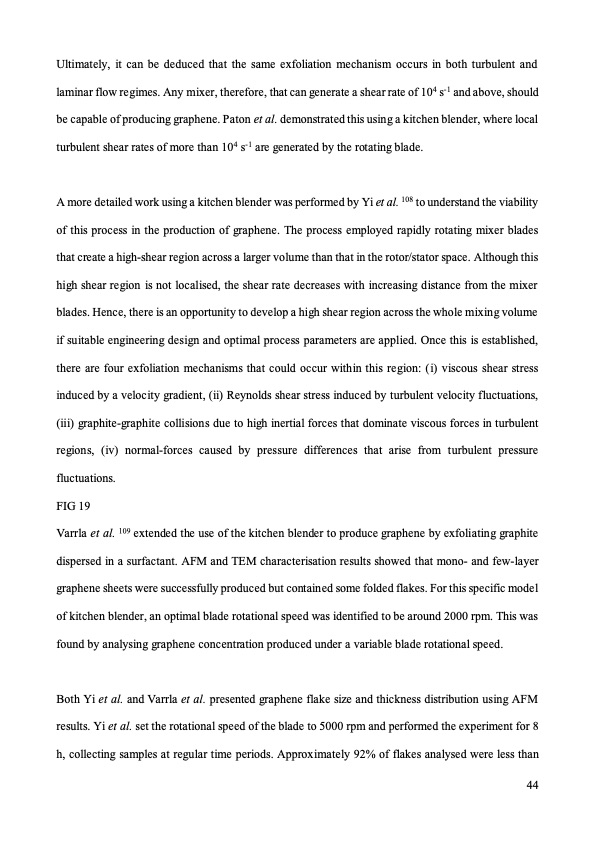
PDF Publication Title:
Text from PDF Page: 044
Ultimately, it can be deduced that the same exfoliation mechanism occurs in both turbulent and laminar flow regimes. Any mixer, therefore, that can generate a shear rate of 104 s-1 and above, should be capable of producing graphene. Paton et al. demonstrated this using a kitchen blender, where local turbulent shear rates of more than 104 s-1 are generated by the rotating blade. A more detailed work using a kitchen blender was performed by Yi et al. 108 to understand the viability of this process in the production of graphene. The process employed rapidly rotating mixer blades that create a high-shear region across a larger volume than that in the rotor/stator space. Although this high shear region is not localised, the shear rate decreases with increasing distance from the mixer blades. Hence, there is an opportunity to develop a high shear region across the whole mixing volume if suitable engineering design and optimal process parameters are applied. Once this is established, there are four exfoliation mechanisms that could occur within this region: (i) viscous shear stress induced by a velocity gradient, (ii) Reynolds shear stress induced by turbulent velocity fluctuations, (iii) graphite-graphite collisions due to high inertial forces that dominate viscous forces in turbulent regions, (iv) normal-forces caused by pressure differences that arise from turbulent pressure fluctuations. FIG 19 Varrla et al. 109 extended the use of the kitchen blender to produce graphene by exfoliating graphite dispersed in a surfactant. AFM and TEM characterisation results showed that mono- and few-layer graphene sheets were successfully produced but contained some folded flakes. For this specific model of kitchen blender, an optimal blade rotational speed was identified to be around 2000 rpm. This was found by analysing graphene concentration produced under a variable blade rotational speed. Both Yi et al. and Varrla et al. presented graphene flake size and thickness distribution using AFM results. Yi et al. set the rotational speed of the blade to 5000 rpm and performed the experiment for 8 h, collecting samples at regular time periods. Approximately 92% of flakes analysed were less than 44PDF Image | graphene production via nonoxidizing liquid exfoliation

PDF Search Title:
graphene production via nonoxidizing liquid exfoliationOriginal File Name Searched:
Graphene-R2-review.pdfDIY PDF Search: Google It | Yahoo | Bing
Salgenx Redox Flow Battery Technology: Power up your energy storage game with Salgenx Salt Water Battery. With its advanced technology, the flow battery provides reliable, scalable, and sustainable energy storage for utility-scale projects. Upgrade to a Salgenx flow battery today and take control of your energy future.
| CONTACT TEL: 608-238-6001 Email: greg@infinityturbine.com | RSS | AMP |